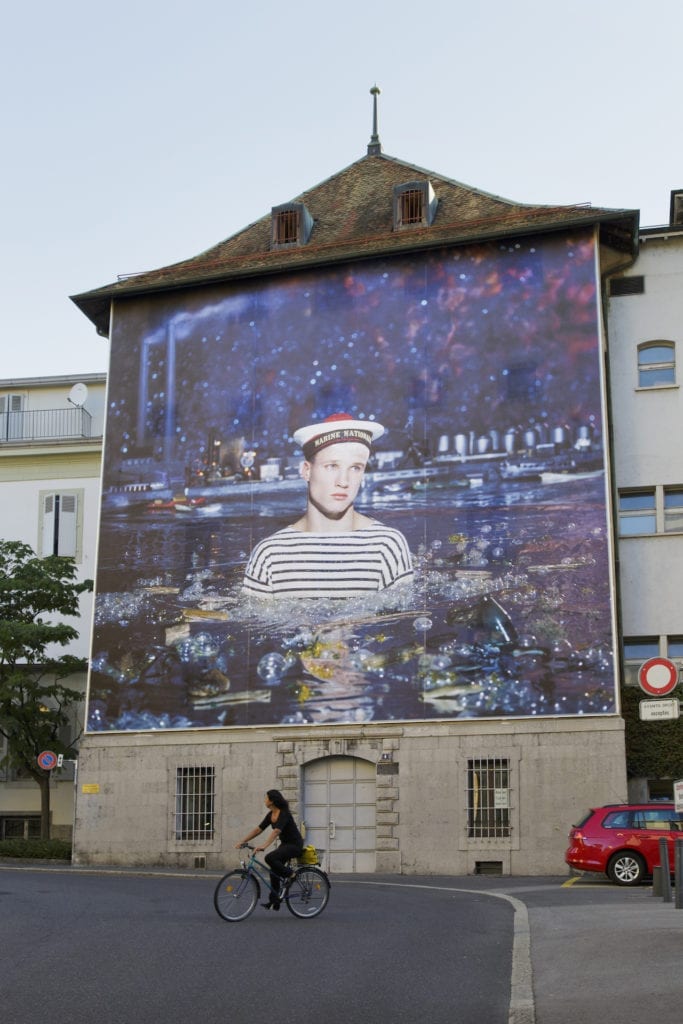Festival Images Vevey is known for its innovative photography installations, but in 2016 it outdid itself, placing images on the bottom of Lake Geneva, hiding them behind peep-holes, and much more. “The festival is interesting because it uses photography so unconventionally,” says Erik Kessels, the Amsterdam-based artist and art director who has shown his work and been a regular visitor at the biennial, and who recommended it to BJP. “It’s experimental, unafraid of risk.”
The Swiss festival has been going since 1997, but when Stefano Stoll was asked to take over in 2008, it was in the doldrums. “It was a festival pretty much as any other,” he says. “You bought a ticket, entered a couple of galleries and discovered framed images on the walls. It wasn’t attracting many visitors, and the sponsors weren’t happy. I was tasked with coming up with a more innovative concept.”
Stoll had previously co-founded a more conventional festival so he wasn’t interested in repeating himself, and felt there was little point trying to replicate what others were already doing so successfully in Arles and elsewhere. Instead he starting thinking about the town’s motto, ‘Vevey ville d’image’, dreamt up because it houses one of the world’s oldest photography schools, and the Swiss National Camera Museum.
“The town had this marketing tag, which was there for good reasons but wasn’t really working either,” says Stoll. “I thought, why not take it literally and turn Vevey into a real city of images during the three weeks? Why not solve two problems with one answer?”
The result is extraordinary – a three-week expo in which images are shown not just in public displays but in cutting-edge installations that use the very fabric of the town. “We wanted to show images in an inspiring way, not just make the kind of public displays you see everywhere,” says Stoll.
“Just showing work doesn’t do anything if people don’t stop to look, don’t laugh, don’t engage with it. We wanted to make a festival that would be an experience, in which the city would change the work as much as the work would change the city.”

And, as he says, many of the installations require physical interaction from the visitors, be it by diving into Lake Geneva to see Guido Mocafico’s images, or peering into binoculars to see Matjaž Tančič’s work. Making such installations isn’t easy, and Stoll says the team needs the two-year run up to each festival for R&D and prototyping – every ‘off ’ year they also run a competition to find new talent to commission, which is currently open for entries.
“This year there were 75 shows, but we worked on more than 180 projects and ideas,” he says. “In the end, some were not technically possible or financially viable or the building owner didn’t agree – there are so many reasons ideas can not work out because, when you’re trying to do something new in the public space, there are so many unknowns and last-minute surprises. One year we put a show on the rooftops and flew a drone to allow people to see it. But it nearly fell through just before the festival because the Swiss government changed the law on drones.”
And while these installations are designed to be innovative and engaging, Kessels says they avoid becoming gimmicky because of the close correlation between subject matter, space and presentation. Mocafico’s shots were submerged below water because they show intricate glass sculptures of sea creatures; Tančič’s were shown through spy-glasses because they showed North Korea. “Everything is very precise and very thought-through,” he says. “It is very specific.”
Grand Prix Images Vevey offers one artists CHF 40,000 to develop an original project which will be presented at the next Festival Images Vevey in September 2018. The festival also runs a separate competition called the Images Vevey Book Award, which offers one artist a CHF 1000 to create a book project. Both competitions are open for entries until 26 February, for more information, visit www.images.ch
